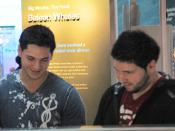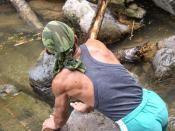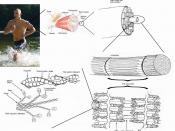The Muscular System
Muscles are what allow and make your skeleton able to move around. The muscles are attached to the bones by strips of dense connective tissue called tendons. The origin is one end of the muscle which remains stationary during a muscle contraction. This gives the muscle something to pull against. The insertion is the other side of the muscle, it is attached to a bone that moves when the muscle contracts. A muscle's insertion always moves towards its origin. Flexors cause the limbs to bend at a joint, while extensors cause them to straighten. One muscle pulls the bone in one direction the other pulls it back. When you move, both muscles are not told to move at the same time. If they moved at the same time your bones wouldn't move anywhere. There are small fibers called myofibrils, which are within each larger muscle fiber. The myofibrils, in turn, contain many filaments of the proteins myosin actin.
One end of each actin filament is anchored at a Z line, which is the location of a protein that crosses a myofibril. Myosin and actin filaments lie parallel to one another and are arranged in sarcomeres, repeating units that are bounded by two Z lines.
Some athletes are tempted to use drugs called anabolic steroids to increase the size (and the strength) of their muscles. A muscle strain, commonly called a pulled muscle, is the overstretching or tearing of a muscle. Muscle strain occurs when a muscle is overused or when strenuous exercise is done without warming up exercises. A sprain is a torn or overly stretched muscle, ligament, or tendon. If excessive stress causes the tendons that the muscles attach to bone to become inflamed, then tendonitis results, which is an extremely painful condition.


